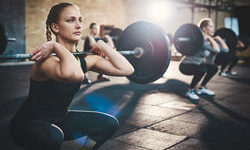
With the world famous Wimbledon Tennis Tournament just around the corner, we look at tennis fitness and how you can achieve the fitness levels of Roger, Rafa, Serena or Johanna.
Tennis fitness comprises a number of components. Probably the most important is endurance. Tennis players must be able to perform and stay mentally focused for long periods of time. Like any activity, as soon as a tennis player starts to get physically tired, so the mental process start to deteriorate.
But it is not solely about endurance. Today’s tennis professionals need to have strength, speed, agility and fast reflexes as well. Legs should be strong and yet agile, able to change direction quickly. The shoulders and arms provide the power behind the shots and a strong core holds it all together. Tennis fitness requires all these elements.
Tennis fitness you can do anywhere
One great workout that will provide the basis for your tennis fitness is interval training. Jogging five miles will not cut it, you have to do short bursts of speed work, with minimal recovery. Do a warm-up, then perform sprints that replicate the length of the court, jog back to recover and then repeat. You can also do this sideways and backwards, replicating moves you might make on the court.
10 x 5 metre sprints. 2 minute jog recover, then repeat. Do this five times in total.
Move like a tennis pro
To be a successful tennis player, you must train your muscles to cope with the movements you use on court. This includes side-stepping and running backwards. Mark out a square with a starting point in the middle. Making sure you are always looking forwards, run to each of the corners, touch the ground, then return to the starting point. This will force you to run backwards as well as forwards.
Do the same with each side of your square, side-stepping or running at an angle as fast as you can, before returning to the centre.
The more times you repeat these movements, the stronger the ligaments, tendons and muscles that are involved in the movement will become.
Strength training and circuits
Circuits and/or strength and conditioning work are an essential part of a tennis player’s fitness regime. Exercises such as press-ups, crunches, star jumps, squat thrusts, squats and lunges are all great ways to prepare the body for tennis.
When it comes to weights, it is best to work towards muscular endurance rather than maximum strength. For that reason, the strength component of tennis fitness should be about high repetitions and moderate weights. Not one rep of the highest weight possible.
You are looking to strengthen the muscles and tendons that will come under strain when you are hitting a ball. For this, any form of bicep exercise will be beneficial. Standard curls, preacher curls, hammer curls are all great for tennis fitness.

Flyes and lateral raises are also great exercises for shoulder and back power. They develop the muscles that allow you to really power through your shots.
A well-balanced conditioning programme specifically for tennis would comprise: squats, lunges, shoulder press, pull-ups, push ups, dumbbell flies, bicep curls, calf raises, leg extensions, jumping jacks, box jumps and skipping.
Tennis fitness should balance endurance, speed, muscular endurance, strength, flexibility and cardio.
And once you have started your tennis fitness training, how about putting your tennis skills to the test on one of the local authority tennis courts in Cambridge.







